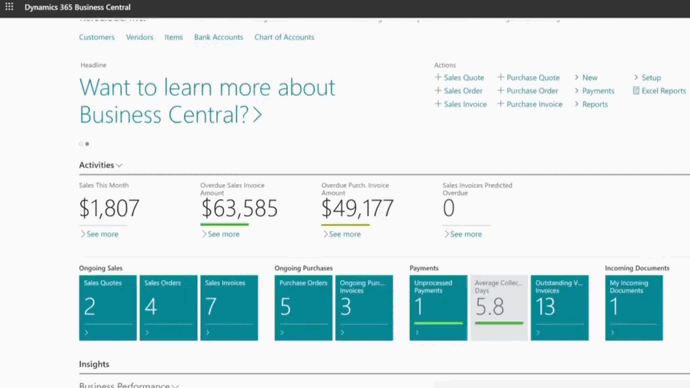Avec un système ERP (Enterprise Resource Planning), toutes les données sont centralisées en un seul endroit.
Des commandes aux ventes entrantes et sortantes, en passant par la chaîne d'approvisionnement et la gestion des stocks, une source unique vous donne accès à des informations logistiques complètes.
Désormais, vous n'aurez plus à rechercher différentes sources de données pour comprendre vos informations logistiques. Vous pouvez tout gérer à partir d'une source unique et cohérente!
Les logiciels ERP changent la donne pour toutes les entreprises, et c'est sans aucun doute une solution à envisager pour la vôtre.
Vous n'êtes pas encore convaincu ? Continuez à lire !
Quel est le rôle d'un ERP dans une entreprise manufacturière?
On commence par la base
Un logiciel ERP est un système qui intègre différents processus et fonctions de l'entreprise. Il s'agit notamment des finances, des ressources humaines, de la fabrication, de la chaîne d'approvisionnement et de la logistique, au sein d'une base de données centralisée. Il fournit une vue unique et complète des données d'une organisation et permet une gestion efficace des ressources, des opérations et des informations.
Dans le contexte de la logistique, un système ERP simplifie et automatise les opérations logistiques en maintenant une visibilité, un contrôle et une optimisation en temps réel de l'ensemble de la chaîne d'approvisionnement. Il facilite la prévision précise de la demande, la gestion des stocks, le traitement efficace des commandes, la planification du transport, la gestion des entrepôts, ainsi que le suivi et la traçabilité des marchandises.
Vous cherchez un logiciel de gestion de logistique ?
Un ERP est ce que vous avez besoin. Contactez-nous pour en savoir plus sur notre solution Microsoft Dynamics 365 et comment nous pouvons vous aider avec votre gestion logistique.
 Appel découverte gratuit
Appel découverte gratuit
Amélioration de l'efficacité générale, rien de moins!
Un système ERP élimine les tâches redondantes, les processus manuels et les silos de données.
Les données enregistrées en temps réel permettent aux gestionnaires de connaître l'état des stocks, l'avancement des commandes et les éventuels problèmes de niveau de stock ou de livraison.
Pour faire simple, un système ERP permet de :
- Réduire le volume de l'inventaire;
- Optimiser les opérations de la chaîne d'approvisionnement;
- Maximiser l'efficacité opérationnelle;
- Expédier la commande de chaque client dans les délais;
- Simplifier la planification des ressources;
- Et enfin, prendre des décisions éclairées !

Visibilité et contrôle renforcés
Grâce à un système ERP, les entreprises disposent d'informations en temps réel sur leurs opérations logistiques, telles que les niveaux de stock, l'état des commandes, le suivi des expéditions et l'analyse des performances. Cette visibilité permet une prise de décision proactive, une planification précise et une gestion efficace des risques.
Réduction des coûts
Un système ERP aide les entreprises à réduire les coûts en optimisant les niveaux de stock, en prévoyant la demande avec précision, en utilisant les itinéraires de transport et en effectuant des tâches de manière automatisée.
Satisfaction de la clientèle
Un système ERP permet aux entreprises de fournir un meilleur service à la clientèle en assurant une livraison dans les délais, une exécution précise des commandes et une communication efficace tout au long de la chaîne d'approvisionnement. Il en résulte une plus grande satisfaction des clients, une plus grande fidélité et un renouvellement des contrats.
Évolution et croissance
Au fur et à mesure que les entreprises étendent leurs activités, un système ERP facilite l'évolutivité en offrant des modules flexibles et des options de personnalisation. L'industrie manufacturière a également besoin d'une intégration ERP avec d'autres solutions logicielles telles que la gestion du transport, la gestion de la relation client, le système de gestion d'entrepôt, etc. Une intégration aisée permettra aux entreprises de gérer des volumes de transactions accrus, de s'adapter à l'évolution des demandes du marché et de soutenir leur croissance future.

Respect de la réglementation
Un système ERP aide les entreprises à respecter les réglementations sectorielles liées à la logistique, telles que les douanes, la conformité commerciale, la sécurité des produits et les exigences en matière de traçabilité. Il fournit une documentation précise, des pistes d'audit complètes et permet de se conformer aux obligations légales de votre industrie.
Quelques caractéristiques essentielles d'un système de gestion logistique ERP
Listes d'inventaire
C'est là une des fonctions les plus utiles : affichez tous vos produits sous forme de liste. Vous pourrez ainsi trier, classer, organiser ces mêmes marchandises en groupe ou en classe. Vous y trouverez un affichage complet des stocks, du coût, du coût moyen pondéré, des réapprovisionnements, ainsi que de l'historique des stocks. Un panel complet vous donnant donc un libre accès à chacune des données relatives aux produits dans un listage dont vous seul établirez les critères.
N'hésitez à lire notre article sur les avantages d'un logiciel ERP pour la gestion d'inventaire !
Les variables et détails produisent
Ici vous pourrez ajouter des informations à chaque produit, à chaque catégorie de produit. Y ajouter aussi bien des variantes que des détails : du code SKU, aux codes-barres, à un code fournisseur. Des options, aussi, de taille, de poids, de prix d'achat. Enfin vous aurez l'opportunité de gérer les coûts et de les visualiser à travers des panneaux de prix tel que : vente en gros, vente au détail, taxe, etc.
L'historique produit
Chaque produit disposera d'un suivi particulier, bref d'un historique retraçant chaque mouvement du même produit. Une chose qui vous sera utile dans le réapprovisionnement de celui-ci, de l'équipe mise en place pour le gérer, ainsi qu'un cahier des dates permettant de tracer de la réception à l'envoi du produit.
Un scanner de codes-barres
Le scanner de codes-barres vous permettra ici rechercher les produits présentant un code-barre. D'entrer ainsi les informations détaillées de chaque article, ainsi que de paramétrer la date de commande et d'achat. Un système optimal fonctionnant d'ailleurs avec tous les codes-barres existants.

Un rapport de réapprovisionnement
Vous trouverez ici une aide au réapprovisionnement. Chose qui vous permettra et de prédire quand réapprovisionner, et de vous présenter : le nom du fournisseur, le nombre de produits à réapprovisionner, les variables en prendre en considération ainsi qu'un lien vers la page de rapport complet.
Assurer une gestion harmonieuse vos employés
La gestion de votre personnel peut, parfois, être un vrai casse-tête. Encore plus quand vous possédez une entreprise de logistique où vos employés peuvent se trouver n'importe où à n'importe quelle heure.
Gérer votre personnel dans le cas ci-contre peut donc être une vraie problématique d'entreprise. Aussi, avec un système ERP, cette logistique se trouvera simplifier, au paroxysme même de la facilité. Grâce aux logiciels vous pourrez :
- Gérer les heures de vos employés ainsi que les pauses midi et repas
- Gérer les informations liées à chaque employé ainsi que leur dossier
- Suivre vos personnels sur les routes
- Gérer les augmentations et les primes salariales
- Augmenter la productivité de chaque employé
- Gérer les congés maladie
- Gérer les intérimaires ou le personnel saisonnier
- Fournir une liste complète du personnel (permanent ou occasionnel) présent, en cas d'urgence notamment
Réduire vos coûts de manutention et d’envoi
La précision des données d'un logiciel ERP vous permettra, entre autres, de gérer à merveille vos dépenses. Elles vous permettront de comprendre vos secteurs de dépenses, de les réduire, de prendre une décision plus rapidement, et plus précisément. Vous aurez ici l'occasion de mettre en avant la pleine puissance de l'ERP, en évitant les commentaires parasites, les conseils non avisés : ici vous ne vous baserez que sur les chiffres pour décider.
Vous serez en mesure de gérer les problèmes dans l'immédiat, tout en garantissant un coût maitrisé. Évitant par la même occasion que cet aléa ne devienne un gouffre pour votre business. Vous augmenterez donc votre productivité tout en maintenant une logistique parfaite à travers une visibilité en temps réel de vos opérations, ainsi qu'un accès instantané à vos chaînes d'approvisionnement mondiales.
Planifiez une consultation avec un de nos experts
Contactez notre équipe pour tout savoir sur nos services et solutions et comment nous pouvons vous aider avec l'implantation d'un ERP, un logiciel capable de vous aider dans la gestion logistique.
 Appel découverte gratuit
Appel découverte gratuit
Les avantages d'un logiciel ERP pour la gestion de votre logistique
Zoom rapide mais détaillé, sur les avantages d'un tel logiciel :
1. Un transfert de stock entre entrepôts maitrisé
Créez facilement un document de transfert de stock. Gérez, analysez, déplacez vos stocks entre chacun de vos entrepôts sans aucune surprise. Et dans les délais impartis.
2. Réceptionnez vos stocks dans un entrepôt spécifique
Réceptionnez un stock dans n'importe quel entrepôt. Vous spécifierez ici et le magasin où vous souhaitez recevoir le stock, et son emplacement une fois la commande reçue.
3. Exécutez les commandes d'un entrepôt spécifique
Spécifiez le site à partir duquel vous souhaitez envoyer vos marchandises. Le stock de cet emplacement spécifique diminuera automatiquement lorsque la commande client sera remplie.
4. Suivez l'état de vos commandes
Gérer les emplacements de vos commandes dans les différents entrepôts. Suivez et imprimez les listes de commandes une fois l'étape d'expédition atteinte pour un suivi et une gestion optimale.
5. Consignez et vendez vos produits
Configurez un nouveau magasin. Effectuez un transfert de stock à l'intérieur même, et livrez où envoyer des commandes client à partir de ce nouvel emplacement.
6. Gérez vos entrepôts selon leur lieu
Gérez vos entrepôts à distance. Sélectionnez un emplacement et vérifiez-y : le stock, les commandes, le dernier stock acheté, le taux de réapprovisionnement, le montant du profit ainsi que vos marges bénéficiaires.
Vous l'aurez compris l'ERP va vous faire économiser de l'argent. Et c'est d'ailleurs une étude qui le prouve : les coûts opérationnels et administratifs seront réduits de 23 à 22 % respectivement. Les entreprises désirant même voir un ERP sur mesure pourront personnaliser le logiciel afin qu'il réponde à la perfection à leurs besoins. Et c'est une autre étude qui vient confirmer directement ce point, puisque 93 % des utilisateurs personnalisent leur ERP selon leur besoin.

Au-delà de la routine : transformez votre entreprise avec un ERP
En conclusion un logiciel ERP vous permet de mieux gérer votre entreprise. De maintenir des stocks à la perfection, sans encombrer vos entrepôts. Mais ce n'est pas tout, non seulement vous améliorerez votre logistique via chacun des outils des logiciels mais en plus vous gagnerez du temps.
Vous permettant une organisation forte et parfaite, le logiciel ERP vous assure la traçabilité de chacun de vos produits, aussi bien que chacun de vos salariés. Avec une foule de données sur chacun des facteurs de vos productions, vous pourrez et optimiser vos coûts, et augmentez la productivité de vos salariés.
Enfin vous pourrez analyser les défauts de votre chaîne de production, pour dans ce cas, créer de meilleurs maillons qui, eux aussi, vous aideront à toujours travailler mieux, travailler plus vite.
Choisir une solution ERP s'impose donc à qui désire augmenter sa productivité tout en diminuant chacun des coûts logistiques et administratifs inhérents à la gestion d'entreprise. Parlez-nous de vos besoins en implantation ERP.
Vous avez aimé ce que vous venez de lire? Partagez-le!

17 juin 2025 par Kooldeep Sahye par Kooldeep Sahye Marketing Specialist
Passionné par tout ce qui touche au référencement, aux mots-clés et à l'optimisation du contenu. Et un rédacteur enthousiaste qui s'épanouit dans le storytelling et le contenu pertinent.

